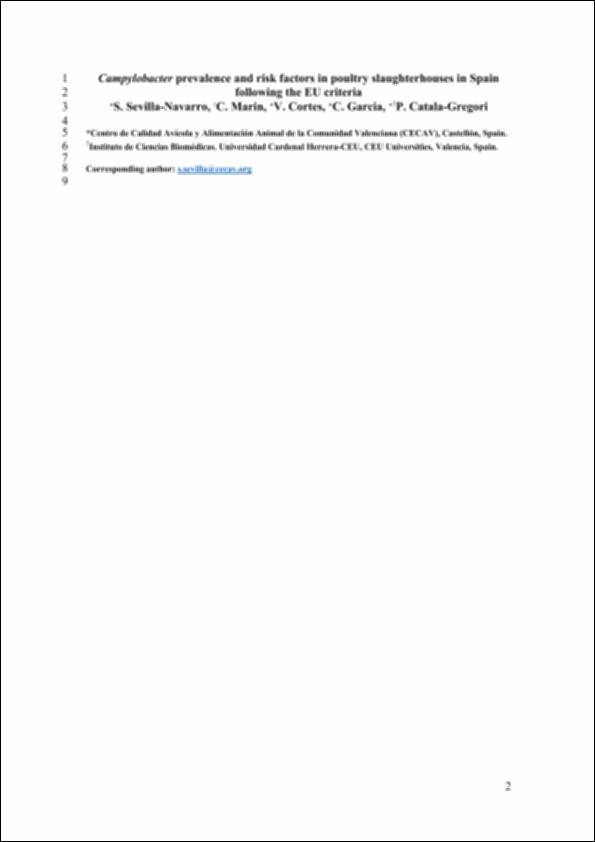Please use this identifier to cite or link to this item:
http://hdl.handle.net/10637/13872"Campylobacter" prevalence and risk factors associated with exceeding allowable limits in poultry slaughterhouses in Spain
| Title: | "Campylobacter" prevalence and risk factors associated with exceeding allowable limits in poultry slaughterhouses in Spain |
| Authors : | Sevilla Navarro, Sandra Marín Orenga, Clara Cortés Moñiz, Verónica García Bover, Cristina Catalá Gregori, Pablo |
| Keywords: | Bacteriología veterinaria.; Mataderos.; Slaughtering and slaughter-houses.; Vibriosis - Prevención - España.; Campylobacter - Control.; Poultry - Preservation.; Carne de ave - Conservación.; Veterinary bacteriology.; Vibriosis - Prevention - Spain.; Alimentos - Control de calidad.; Food - Quality. |
| Publisher: | John Wiley & Sons British Veterinary Association |
| Citation: | Sevilla-Navarro, S., Marin, C., Cortés, V., García, C. & Catalá-Gregori, P. (2020). Campylobacter prevalence and risk factors associated with exceeding allowable limits in poultry slaughterhouses in Spain. Veterinary Record, vol. 186, i. 13 (apr.), p. 415. DOI: https://doi.org/10.1136/vr.105558 |
| Abstract: | Background: Campylobacter is the main pathogen involved in zoonotic gastrointestinal diseases. Last year, the European regulation 2017/1495 on Campylobacter in broiler carcasses came into force. In this context, the aim of this study was to assess the potential risk factors associated with exceeding the 1,000 CFU/g criterion set by the European Commission in several slaughterhouses in Spain. Methods: Information relating to 12 factors were collected using questionnaires. Samples were collected from 12 Spanish abattoirs during June, July and August 2017 (n=1,725) and were analysed following ISO/TS 10272-2:2006 method. Results: The proportion of Campylobacter-positive samples was 23.7% (n=409). Analysis of the flock age (41-50 days) revealed a significantly increased OR in Campylobacter enumeration (OR=7.41). Moreover, scalding temperature (51.9.54 ºC) was positively associated with an increase in OR (OR=2.75). Time in transit to slaughter (1-1.5h), showed a significant OR decrease (OR=0.25). However, when processed for more than 2 hours, presented an increase in OR (OR=4.44). Regarding carcass weight, the range from 3.21-3.58 presented a decrease in OR (OR=0.01). Conclusion: The outcomes of this study suggest that although most chickens are contaminated by the bacterium, the prevalence that exceeds the limit of 1,000 CFU/ is not so high as we thought. |
| Description: | Este artículo se encuentra disponible en la siguiente URL: https://bvajournals.onlinelibrary.wiley.com/doi/epdf/10.1136/vr.105558 This is the pre-peer reviewed version of the following article: Sevilla-Navarro, S., Marin, C., Cortés, V., García, C., & Catalá-Gregori, P. (2020). Campylobacter prevalence and risk factors associated with exceeding allowable limits in poultry slaughterhouses in Spain. Veterinary Record, vol. 186, i. 13 (apr.), p. 415, which has been published in final form at https://doi.org/10.1136/vr.105558. This article may be used for non-commercial purposes in accordance with Wiley Terms and Conditions for Use of Self-Archived Versions. Este es el pre-print del siguiente artículo: Sevilla-Navarro, S., Marin, C., Cortés, V., García, C., & Catalá-Gregori, P. (2020). Campylobacter prevalence and risk factors associated with exceeding allowable limits in poultry slaughterhouses in Spain. Veterinary Record, vol. 186, i. 13 (apr.), p. 415, que se ha publicado de forma definitiva en https://doi.org/10.1136/vr.105558. |
| URI: | http://hdl.handle.net/10637/13872 |
| Rights : | http://creativecommons.org/licenses/by-nc-nd/4.0/deed.es |
| ISSN: | 0042-4900 2042-7670 (Electrónico) |
| Issue Date: | 14-Apr-2020 |
| Center : | Universidad Cardenal Herrera-CEU |
| Appears in Collections: | Dpto. Producción y Sanidad Animal, Salud Pública Veterinaria y Ciencia y Tecnología de los Alimentos |
Items in DSpace are protected by copyright, with all rights reserved, unless otherwise indicated.


